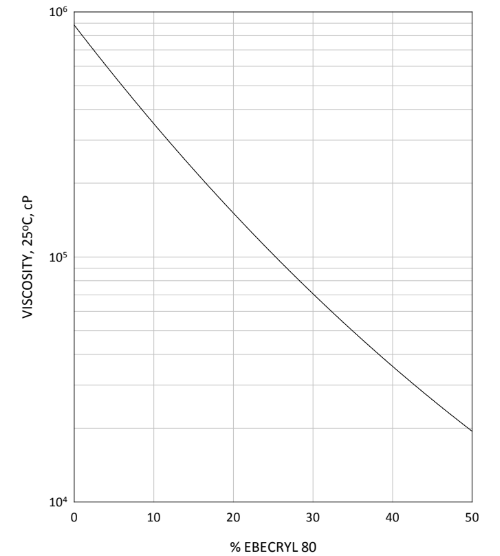Enhanced TDS
Identification & Functionality
- Blend
- No
- CASE Ingredients Functions
- Chemical Family
- Function
- Monomer
- Product Code
- MITM00429
- Single Ingredient
- Yes
- Technologies
- Product Families
Features & Benefits
- CASE Ingredients Features
- Labeling Claims
- Performance Highlights
EBECRYL®80 is characterized by:
- Very fast cure response
- Low viscosity
- Light color
UV/EB cured products containing EBECRYL®80 are characterized by the following performance properties:
- High gloss
- Good solvent resistance
- Low residual odor
The actual properties of UV/EB cured products also depend on the selection of the formulation components such as reactive diluents, additives and photoinitiators.
Applications & Uses
- Application Method
- Coating End Applications
- Compatible Substrates & Surfaces
- Cure Method
- Ink & Toner End Applications
- Markets
- Applications
- Product Application
Formulated UV/EB curable products containing EBECRYL®80 may be applied via direct or reverse roll, offset gravure, metering rod, slot die, knife over roll, air knife, curtain, immersion and spin coating methods as well as flexographic and screen printing.
EBECRYL®80 is recommended for use in:
- Fast curing overprint varnishes
- Clear coatings for wood, paper and plastics
- Top coats for wood
- Flexographic inks and coatings
- Screen inks and coatings
- Wood fillers
Properties
- Physical Form
Technical Details & Test Data
- Technical Data
Table 1 : UV CURE RESPONSE COMPARISON
A B C D EBECRYL 810⁵ 100⁶ EBECRYL 80 100 EBECRYL 81⁷ 100 EBECRYL 83⁸ 100 Photointiator⁹ 3 3 3 3 Photosensitizer¹⁰ 2 2 2 2 Viscosity at 25°C, cP/mPa·s 504 3350 139 622 UV energy¹¹, mJ/cm² 640 <90 230 110 Cure speed, fpm 30 200 110 155 ⁵ EBECRYL 810 is a tetrafunctional polyester acrylate, product of Allnex
⁶ Parts by weight
⁷ EBECRYL 81 is a 2.5 functional amine modified polyether acrylate, Allnex
⁸ EBECRYL 83 is a tetrafunctional amine modified polyether acrylate, Allnex
⁹ 2-hydroxy-2-methyl-1-phenyl propanone, e.g. Speedcure 73 product of Lambson
¹⁰ Benzophenone
¹¹Coatings were applied to aluminum test panels at ~12 μ thickness and cured with one 300 watt/inch Fusion H lamp at the minimum UV energy required to achieve a mar free surface.- Table 1 compares the cure response of EBECRYL 80 with a polyester acrylate other polyether acrylates and demonstrates the faster reactivity of amine modified polyether acrylates. EBECRYL 80 is notable for exhibiting the highest reactivity.
- Viscosity Reduction
GRAPH I: EBECRYL®80- VISCOSITY REDUCTION OF EBECRYL 3700

- Graph I shows the viscosity reduction of EBECRYL 3700¹ when diluted with EBECRYL®80.
- ¹ Product of Allnex
Packaging & Availability
Principal Information
- Group Principal Number
- S000001
- Principal
Storage & Handling
- Storage and Handling Conditions
- Care should be taken not to expose the product to high temperature conditions, direct sunlight, ignition sources, oxidizing agents, alkalis or acids.
- This might cause uncontrollable polymerization of the product with the generation of heat.
- Storage and handling should be in stainless steel, amber glass, amber polyethylene or baked phenolic lined containers.
- Procedures that remove or displace oxygen from the material should be avoided.
- Do not store this material under an oxygen free atmosphere.
- Dry air is recommended to displace material removed from the container.
- Wash thoroughly after handling.
- Keep container tightly closed.
- Use with adequate ventilation.
Other
- Appearance
- Clear liquid
- Appearance (SDS)
- Liquid
- Color (SDS)
- Clear to light amber
- Item Number
- Odor (SDS)
- Ester like
- Other Hazards
- Polymerization may occur from excessive heat, contamination or exposure to direct sunlight .
- Protect from Freezing
- Yes
- Temperature Control
- Yes
- USA/DOT UN Number
- Not Applicable
- Chemical Properties
Value Units Test Method / Conditions Free Amine Content 920.0 - - Material Composition
Value Units Test Method / Conditions Oligomer Content 100.0 - - Mechanical Properties
Value Units Test Method / Conditions Elongation 7.0 - at break, UV cured 125 μ thick films Tensile Modulus 1310.0 MPa MPa at break, UV cured 125 μ thick films Tensile Modulus 196000.0 psi psi UV cured 125 µ thick films Tensile Strength 47.0 MPa MPa at break, UV cured 125 μ thick films Tensile Strength 6800.0 psi psi UV cured 125 µ thick films - Optical Properties
Value Units Test Method / Conditions Color Scale max. 200.0 APHA APHA - Physical Properties
Value Units Test Method / Conditions Density 1.11 g/mL g/mL At 25°C Glass Transition Temperature (Tg) 50.0 °C °C Dynamic Mechanical Analysis (DMA) at break, UV cured 125 μ thick films Glass Transition Temperature (Tg) 50.0 °C °C Dynamic Mechanical Analysis (DMA) UV cured 125 µ thick films Storage Temperature 39.2-104.0 °F °F Viscosity 2700.0-3300.0 - At 25°C - SDS Physical and Chemical Properties
Value Units Test Method / Conditions Boiling Point (SDS) min. 100.0 °C °C Density (SDS) 1.11 g/cm³ g/cm³ Vapor Pressure (SDS) max. 1.33 - at 20°C Viscosity (SDS) 2700.0-3300.0 - at 25°C Volatile Content (SDS) max. 0.3 - - Shelf Life & Stability
Value Units Test Method / Conditions Shelf Life 0.0 -
